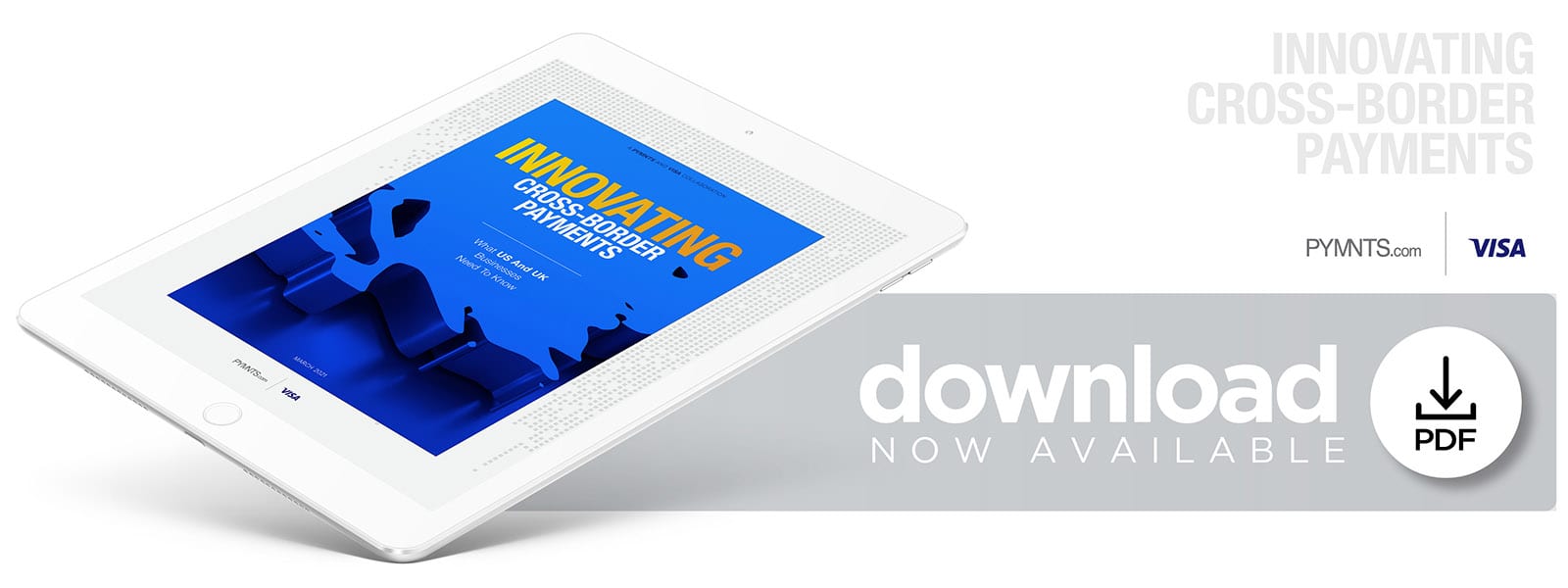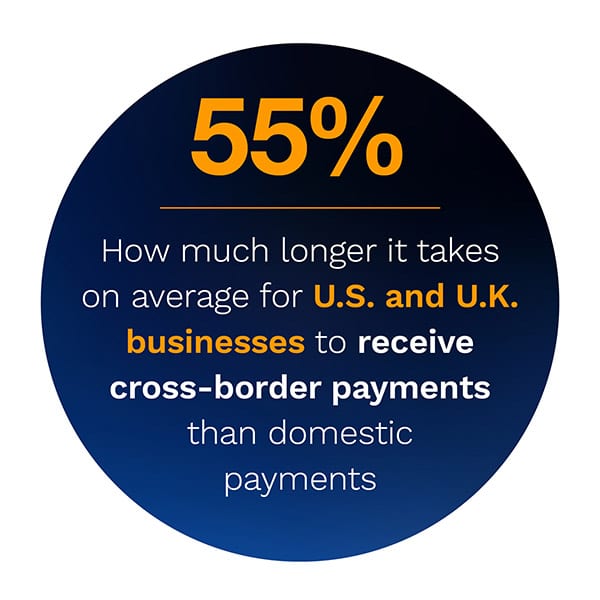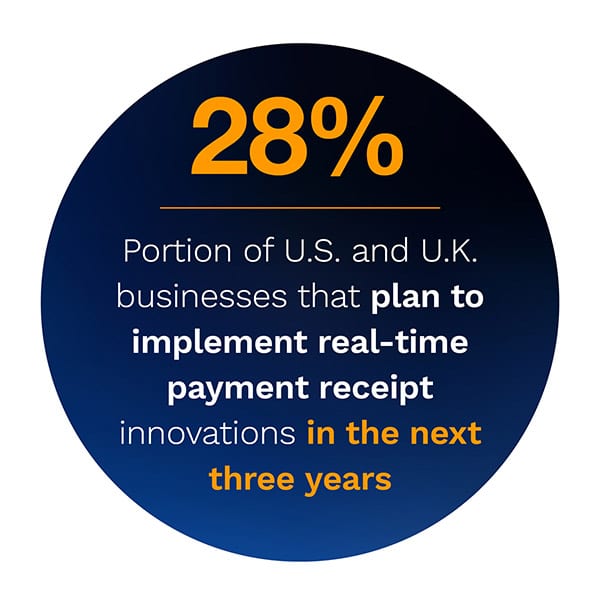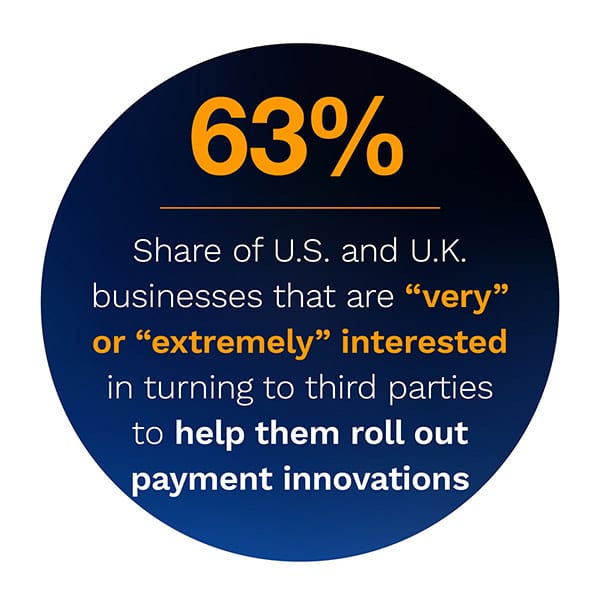NEW REPORT: US, UK Firms Prioritize Innovation To Speed X-Border Payment Flows

 Cross-border commerce has become central to the success of countless United States and United Kingdom businesses, many of which are looking abroad for new growth opportunities. PYMNTS’ latest research shows that cross-border sales make up 26 percent of the total annual average for U.S. and U.K. businesses, in fact, making the management of cross-border payments a key component of their broader payment operations.
Cross-border commerce has become central to the success of countless United States and United Kingdom businesses, many of which are looking abroad for new growth opportunities. PYMNTS’ latest research shows that cross-border sales make up 26 percent of the total annual average for U.S. and U.K. businesses, in fact, making the management of cross-border payments a key component of their broader payment operations.
 Unfortunately, many of these businesses’ cross-border payment flows are mired in clunky legacy processes — including correspondent banking practices — that can make it more difficult for payors and payees alike to manage their cross-border payment flows. Both U.S. and U.K. businesses wait 55 percent longer on average to receive cross-border payments than they do domestic payments, for example, and more than one-quarter are concerned that factors such as payments fraud and unpredictable financial exchange (FX) rates could impede their ability to efficiently conduct cross-border commerce.
Unfortunately, many of these businesses’ cross-border payment flows are mired in clunky legacy processes — including correspondent banking practices — that can make it more difficult for payors and payees alike to manage their cross-border payment flows. Both U.S. and U.K. businesses wait 55 percent longer on average to receive cross-border payments than they do domestic payments, for example, and more than one-quarter are concerned that factors such as payments fraud and unpredictable financial exchange (FX) rates could impede their ability to efficiently conduct cross-border commerce.
No two businesses face the same challenges when managing cross-border payment flows, however, and different circumstances call for very different cross-border payment solutions. What innovations are these vastly different businesses examining as they look to ease their major payments pain points? What can their innovation priorities tell us about the future of the cross-border B2B payments ecosystem?
In Innovating Cross-Border Payments: What US And UK Businesses Need To Know, a PYMNTS and Visa collaboration, drills into why cross-border commerce can be a sticking point for decision-makers on both sides of the Atlantic. We surveyed 456 professionals with senior positions in payments roles at both U.S. and U.K. businesses to get firsthand accounts of what they see as the biggest challenges they must overcome to optimize their cross-border payments flows — and which innovations they are  planning to help them do so.
planning to help them do so.
Our research shows that concerns regarding cross-border payment frictions like fraud, FX fluctuations and more have inspired many U.S. and U.K. businesses to invest in digital innovations to make their cross-border payments operations smoother, simpler and more secure. Thirty-one percent are planning to automate their cross-border payables, for example, while 32 percent are planning to automate their cross-border receivables. Forty percent hope to expand their B2B payments offerings by enabling supplier payments to digital wallets, and 11 percent intend to do so by enabling supplier payments to virtual cards.
Closer examination reveals a stunning amount of diversity in the types of payment innovations that businesses of different sizes and in various geographic locations plan to implement, however. Just 18 percent of the largest U.S. businesses already provide real-time payments options, while 28 percent of their U.K. counterparts say the same. U.S. businesses are, therefore, more likely to plan on implementing such payments within the next three years.
Mi d-sized businesses also represent something of a sweet spot for innovations that deal with cross-border payment flow management, which might include expense management controls and rules-based automatic payments. Thirty-six percent of mid-sized businesses in the U.S. and the U.K. plan to adopt rules-based decision-making technologies to help them manage their cross-border payments in the next three years, in fact. This compares to 35 percent of larger businesses and 28 percent of smaller businesses that plan to do the same.
d-sized businesses also represent something of a sweet spot for innovations that deal with cross-border payment flow management, which might include expense management controls and rules-based automatic payments. Thirty-six percent of mid-sized businesses in the U.S. and the U.K. plan to adopt rules-based decision-making technologies to help them manage their cross-border payments in the next three years, in fact. This compares to 35 percent of larger businesses and 28 percent of smaller businesses that plan to do the same.
Even the best-laid innovation plans can fall flat if they are implemented inadequately, however. Innovating Cross-Border Payments: What US and UK Businesses Need To Know therefore goes one step further, examining businesses’ innovation plans and the strategies they are forming to make their cross-border payment dreams a reality.
To learn more about the digital innovations that U.S. and U.K. businesses are prioritizing, download the report.
